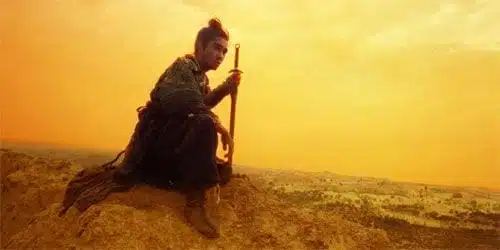
Among the freedoms afforded to filmmakers who are working within a genre is the assumption of audience familiarity. Because viewers already know how the story should end and who the characters are, creators are free to explore dramatic themes and experiment in ways that are more difficult when they are also responsible for establishing their narrative ground and introducing characters in detail rather than through a few simple gestures (casting, costume, a maniacal laugh). However, few filmmakers have taken liberties like those taken by Wong Kar Wai with wuxia in Ashes of Time Redux, a re-edited, remastered, and re-scored version of the original 1994 release.
Structured more like a series of short stories than as a single narrative, Ashes of Time abstracts its genre, leaving viewers to fill in narrative gaps and, even, to play out the expected hand-to-hand combat in their own imaginations. The smaller narratives, each associated with a season, beginning and ending with spring, are tied together by Ouyang Feng (Leslie Cheung), a swordsman who lives alone in the desert both accepting contracts to kill and, more often, brokering deals for other sword masters.
The first story is a love “triangle” between Murong Yin and Murong Yang, a jealous brother and sister pair, both played by Brigitte Lin and both actually the same person (maybe both the same body would be more accurate), and Huang Yaoshi (Tony Leung Ka Fai). The second revolves around a girl who desires that her brother’s death at the hands of bandits to be avenged. Ouyang dismisses her request, but passes it first to a blind swordsman (Tony Leung Chiu Wai) and then to Hong Qi (Jacky Cheung).
Hong Qi’s fight with the bandits occurs in the third story. The final vignette is about Ouyang himself, and his self-imposed exile from White Camel Mountain, his home, and the love of his life, played by Maggie Cheung.
As in his other films, Wong Kar Wai is more interested in exploring the emotional states of his characters than in showing how they became lovelorn, or lonely, or bitter, or content. There are biographical outlines for each, often provided in voiceover by Ouyang, but love has already been lost, or is in danger of being lost, when the characters are introduced.
The movie’s generic grounding not only allows viewers to fill in the character sketches, it also makes such narrative inking and coloring possible. If one has only seen Crouching Tiger, Hidden Dragon (2000) and maybe Hero (2002) and House of Flying Daggers (2004), it should be easy to recognize the lovesick and estranged warriors of Ashes of Time, to feel how their chosen path leads them away from those they love, or to act with arrogance towards others.
All but the final story culminates in the expected fight, but the combat is shot and edited so as to appear fragmentary and phantasmagoric. Confrontations are reduced to beginnings and endings, or go by in a blur. One fight is not shown at all, but is noted only in passing. The most sustained battle is one between Murong Yin and her own reflection on a lake, her sword sending up great fountains of water as she vainly attempts to best herself.
The particulars of the fighting seem less important here than the mere fact of it to the lives of the film’s heavy-hearted and conflicted characters. And like those characters, the scenarios for swordplay are almost instantly recognizable: the lone warrior against a horde of foes, the confrontation that begins with a perceived insult. Even the more unique fight, that of Murong Yin against her own reflection, can be read as a visualization of a wuxia trope, that of the martial artist being at war not just with external antagonists, but also with him or herself.
For his part, Ouyang Feng’s isolation is punctuated by the vastness of the desert. By contrast, the scenes inside his dwelling, and during contract negotiations, verge on the claustrophobic, perhaps suggesting that the loneliness of the landscape leads to an intensification of human contacts. Whatever the semiotic or narrative functions of Christopher Doyle’s photography, Ashes of Time is uniformly beautiful, showcasing vivid colors, which have been enhanced in the redux, and bathed in chiaroscuro.
The DVD includes, Born from Ashes, a short feature on both the original shoot and the genesis of the re-edit and restoration built largely from interviews conducted at the 2008 Cannes Film Festival. The other notable extra is a 40-minute conversation between Wong Kar Wai and film critic J. Hoberman. Wong provides an in-depth outline of the physical and technical task involved in making the new version of the film, and the larger discussion covers questions related to the writer-director’s creative process and body of work. The disc also includes the theatrical preview and additional Sony trailers.
I have not seen the original Ashes of Time or any of the other extant versions (indeed, as David Bordwell documents, it is perhaps impossible to declare a particular version as “original” in an absolute sense). My only experience with the movie is the Redux, which, on its own terms, pushes the wuxia genre to its narrative limits, but in such a knowing, strange, and beautiful way that the ever-present risk of dissatisfaction from what you don’t get to see remains dormant and without consequence.

